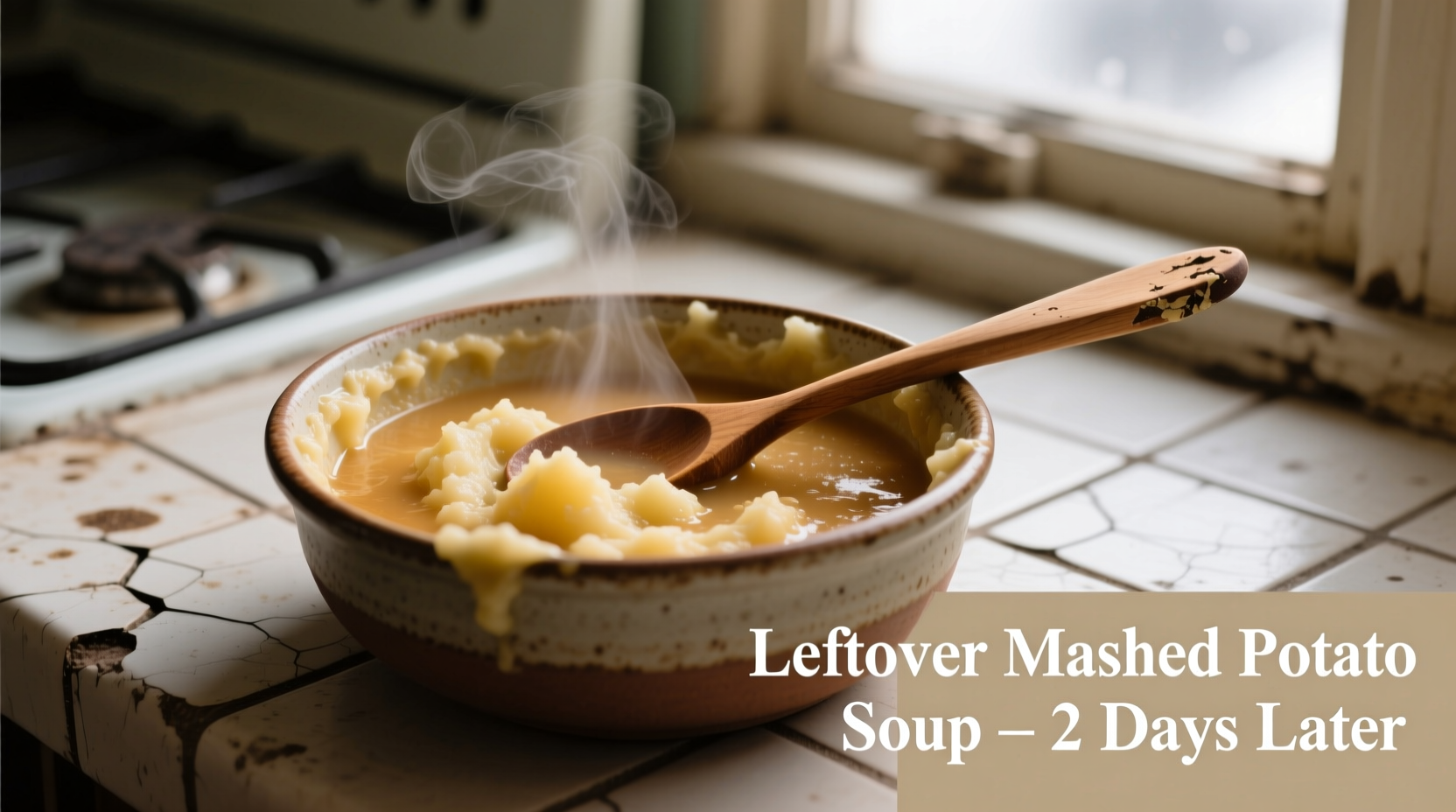Leftover mashed potato soup solves the common dilemma of what to do with yesterday's side dish. Instead of letting those creamy potatoes go to waste, you can create a satisfying main course that's perfect for chilly evenings or quick weeknight dinners. This transformation requires minimal effort but delivers maximum flavor, turning simple leftovers into a comforting meal that even picky eaters will enjoy.
Why Leftover Mashed Potatoes Make Perfect Soup
Potatoes naturally contain starch that acts as a thickening agent, making them ideal for soup bases. According to the USDA Food Safety and Inspection Service, properly stored mashed potatoes maintain their structural integrity for repurposing for 3-4 days when refrigerated. The pre-cooked texture eliminates the lengthy boiling process typically required for potato soups, cutting preparation time significantly.
| Leftover Condition | Best For Soup? | Required Adjustments |
|---|---|---|
| Fresh (1-2 days) | Excellent | None needed |
| Dry or hardened | Good | Add extra liquid during preparation |
| With visible moisture separation | Fair | Drain excess liquid before use |
| Left at room temperature >2 hours | Unsafe | Discard immediately |
Essential Ingredients Checklist
Before you begin transforming your leftovers, gather these kitchen staples:
- 2 cups leftover mashed potatoes (the foundation of your soup)
- 3 cups broth (chicken, vegetable, or bone broth for best flavor)
- 1 small onion, finely diced (aromatic base)
- 2 cloves garlic, minced (flavor enhancer)
- 2 tablespoons butter or olive oil (for sautéing)
- Salt and pepper to taste
Professional chefs at the Culinary Institute of America recommend maintaining a 1:1.5 ratio of mashed potatoes to liquid for optimal soup consistency. This prevents the common mistake of creating a soup that's either too thick or too thin.

Step-by-Step Transformation Process
Building Your Flavor Foundation
Start by creating a flavor base in a medium saucepan. Heat the butter or olive oil over medium heat, then add the diced onion. Cook for 3-4 minutes until translucent, then add the minced garlic and cook for another 30 seconds until fragrant. This foundational step, known as sweating in culinary terms, develops complex flavors without browning.
Creating the Perfect Soup Base
Add your leftover mashed potatoes to the saucepan, breaking up any large clumps with a wooden spoon. Gradually pour in the broth while stirring constantly. This gradual incorporation prevents lumps and ensures even texture. Bring the mixture to a gentle simmer (not a rolling boil) to preserve the delicate potato texture.
Texture Refinement Techniques
For restaurant-quality smoothness, use an immersion blender to achieve your desired consistency. Most home cooks prefer a slightly chunky texture that retains some potato character. If your soup becomes too thick during cooking, add additional broth or milk one tablespoon at a time until reaching your preferred consistency.
Avoiding Common Leftover Soup Mistakes
Food waste statistics from ReFED show that 30% of home-cooked potatoes end up in landfills, often because people don't know how to repurpose them properly. Avoid these frequent errors:
- Overheating: Boiling mashed potato soup causes the starch to break down excessively, resulting in a gluey texture
- Incorrect seasoning: Leftover mashed potatoes often contain salt, so taste before adding more
- Ignoring texture changes: Refrigerated potatoes absorb liquid, requiring additional broth when repurposed
Customization Options for Every Palate
Once you've mastered the basic transformation, experiment with these professional chef-approved variations:
- Loaded Baked Potato Style: Add cooked bacon, shredded cheddar, and chives
- Herb-Infused: Stir in fresh thyme or rosemary during simmering
- Vegetable Boost: Add diced carrots or celery with the onions
- Protein Power: Mix in shredded chicken or cooked ham for a complete meal
Storage and Reheating Guidelines
According to food safety experts at FoodSafety.gov, properly stored potato soup maintains quality for 3-4 days in the refrigerator. For best results:
- Cool soup completely before storing
- Use airtight containers to prevent flavor transfer
- Reheat gently on the stove with a splash of broth to restore consistency
- Freeze for up to 3 months (though texture may change slightly)
Environmental Impact of Repurposing Leftovers
The Natural Resources Defense Council reports that food waste contributes to 8-10% of global greenhouse gas emissions. By transforming your leftover mashed potatoes into soup, you're participating in a meaningful solution. Each pound of food waste prevented reduces your carbon footprint by approximately 2.5 pounds of CO2 equivalent, making this simple kitchen hack both economical and environmentally responsible.
Perfect Pairings for Your Leftover Potato Soup
Complete your meal with these complementary sides that enhance the creamy texture:
- Crusty artisan bread for dipping
- Simple green salad with vinaigrette
- Roasted Brussels sprouts
- Grilled cheese sandwiches (a classic comfort food pairing)











 浙公网安备
33010002000092号
浙公网安备
33010002000092号 浙B2-20120091-4
浙B2-20120091-4